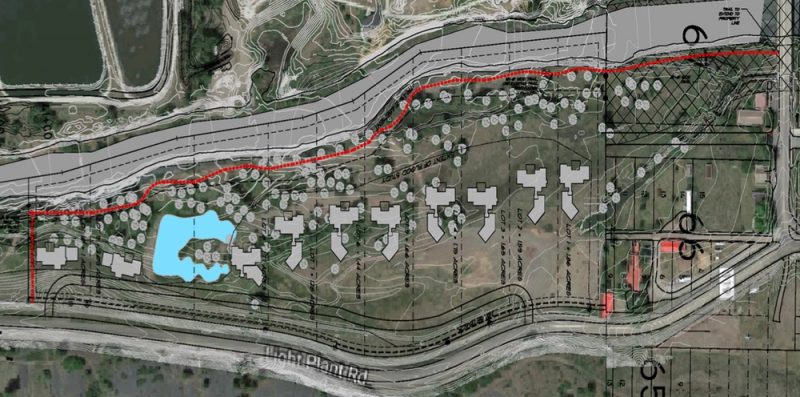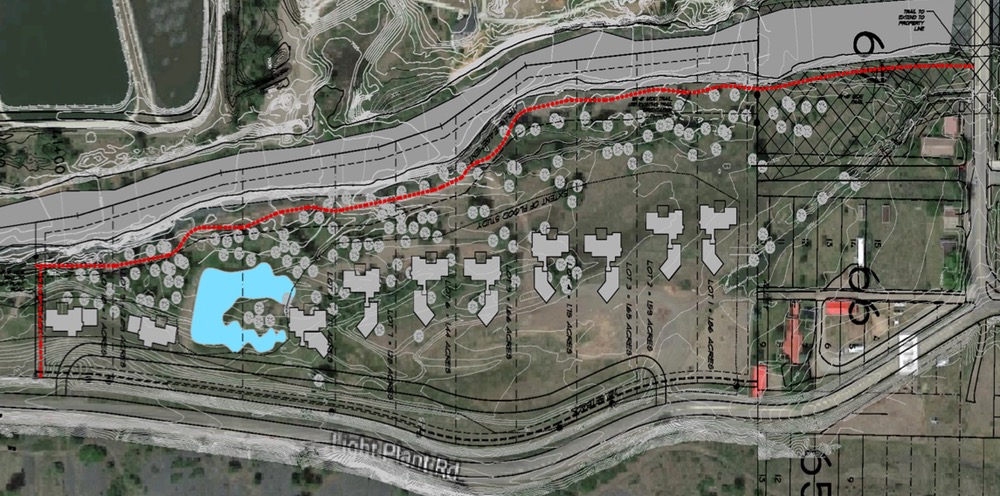The Pagosa Springs Town Council will gather this evening, Tuesday January 7 at 5pm, for their first regular meeting of 2020, and will be discussing the annexation of a good-size parcel just south of Town Hall. The annexation of approximately 16 riverfront acres has been proposed by the development company BWD, LLC, with the idea that they will build 10 single family homes — presumably, high-end homes? — on lots ranging in size from 1-2 acres, with a privately owned and maintained roadway.
The Town’s first gated community? We have gated communities in the unincorporated county, but to my knowledge, no such things within the Town limits.
The Council decision tonight will concern the second reading of Ordinance 923, Annexing Certain Land Known As River Rock Estates Annexation to the Town of Pagosa Springs. which you can download here. It’s my understanding that the proposed high-end subdivision wants to connect to the Town sewer system, while the Town Council wants a dedicated trail easement along the San Juan River, as part of the downtown River Walk trail complex. So it’s a trade, of sorts.
The sketch provided in the Council packet shows the trail easement as a red line that ends (unhappily) on the left side of the map, sort of in the middle of nowhere, on Light Plant Road.
‘South’ is to the left, on this particular map, and the gray strip near the top indicates the San Juan River. Downtown Pagosa is off the map, to the right…

The long-range plan is that more and more suburban subdivisions will be constructed to the south of downtown Pagosa Springs, and so someday, the trail easement granted by River Rock Estates will connect to other suburban trails running through other high-end neighborhoods.
The Town government has allowed numerous annexations in the past; in fact, the Town has initiated annexations in the past, including the annexation of much of the uptown commercial areas… along with most of the commercial properties along Highway 160, between downtown and uptown. I’ve been told that the Town government, back in the 1990s, became concerned about the proposed formation of a separate town government in the Pagosa Lakes area, and won the approval of the uptown commercial property owners to annex them by promising a very low municipal property tax rate.
That move has paid off financially for the Town government — trading a low property tax rate for 50% of the County sales tax collections. As mentioned in previous articles, the Town budget in 2006, prior to the Great Recession, was about $4.5 million. This year’s budget shows expenditures of nearly $13 million.
$12,949,098 to be exact. Not bad for an incorporated town of maybe 800 households. That’s an expenditure of about $16,000 per household. And that number doesn’t even include the Town Sanitation District.
Many people believe that population growth is a primary goal for any community worth its salt. And the best way to grow a tourism-based economy is to build lots of walking trails and recreational amenities and high-end homes. Or so we are told.
So we can expect the Town Council to happily approve Ordinance 923 at their meeting tonight. Happily.
We shared a thoughtful essay yesterday, by columnist Gary Beatty, describing the unfortunate changes that have occurred in his former home town of Clearwater, Florida, thanks in part to the hard work of the local tourism development council. From his essay:
Tourism, augmented by retirees. Does that sound familiar, Pagosa? Been there, done that. It doesn’t end well.
The main intention in this 14-part editorial series has been to raise a central question: “Is population growth a ‘Ponzi’ scheme, as practiced in 21st century America?”
Or more importantly for us, here in Archuleta County: “Is population growth a ‘Ponzi’ scheme, as practiced in 21st century Pagosa Springs?”
From the Town Council packet for tonight’s meeting, regarding the Town’s future responsibilities in connection with 10 high-end homes on Light Plant Road:
The Town will provide very limited services, police service and Riverwalk Trail maintenance, to the annexed property and future proposed development.
The Town is not annexing Light Plant Road. That road is owned and maintained by the County government. We can assume that ten high-end homes — perhaps second homes? — will generate only minimal impacts on Light Plant Road. In other words, the creation of yet another small suburban subdivision will have only minor impacts on Town and County finances and services.
But where does it end?
The approval of dozens of (small or large) suburban subdivisions over the past 50 years, here in Archuleta County, has created over 300 miles of community-maintained streets and roads, and a road maintenance situation that — according to the people who know about these things — is financially impossible to address in a comprehensive manner. It’s especially impossible if our local governments continue putting the taxpayers deeper and deeper into debt via “Certificate of Participation” long-term debt schemes for the construction of oversized government buildings.
I was inspired to begin this editorial series a couple of weeks ago — back in 2019 — by an op-ed in MarketWatch.com, written by Strong Towns founder Chuck Marohn. That article began like this:
For a community, rapid growth is easy. Bolstered by state and federal funding, municipal bond debt financing as well as tax incentives and deferrals, cities and towns that want to induce new development have many means of doing so. With each transaction, they receive immediate fees and tax revenue, but also take on the long-term responsibility to provide ongoing service, maintenance, and — in the case of infrastructure — replacement.
And while that new big box store, strip mall, or drive-thru restaurant may last only a couple of decades, the maintenance obligations from all that asphalt and those new sewer lines are eternal. Too often, though, we haven’t ever bothered to quantify those obligations. When you begin to do the math on our development pattern, what you find is alarming.
Most cities and towns in North America are functionally insolvent. This is not hyperbole. It comes down to a simple question: Is new development producing enough wealth to fund the long-term maintenance of its own infrastructure — let alone public safety and all the other services that we expect government to provide? When we examine these costs and revenue streams, we often find the answer is no.
I live in a house, downtown, built in the year 1900. It has occasional maintenance issues, but nothing that the family can’t handle, even with our limited household income. My family can probably afford to maintain this house, if they wish to, for the next 120 years.
Can Pagosa Springs say the same?

